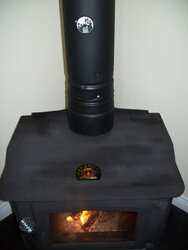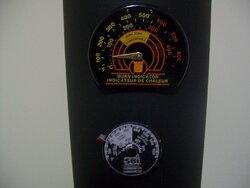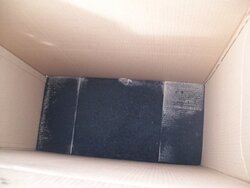I'm new to the forums and happy to finally find a board for wood burners!
I had a new 6" prefab chimney installed last summer and put in an FW2470 stove made by Century Heating (owned by SBI, same co. as Drolet). The stove has been used daily since November and I make sure that I run it hot and not allow smouldering fires. Cord wood has ranged from dry to somewhat dry (usually mixed together) but never green or waterlogged. I've also used BioBricks made by a hardwood processing plant in Woodstock, NB. The probe temps range from 400 - 600 degrees when burning.
A few concerns have come up in the past week and I hope someone can offer some advice:
1). I noticed my doublewall stove pipe seemed hotter to the touch than usual even when the probe thermometer read 400 degrees. So I pulled down the pipe and saw a lot of soot buildup for the 4 months it was in use. Can this layer of soot soak up the heat and cause the doublewall to feel hotter than clean pipe? The soot was light and fluffy from the stove connector to the first 45 elbow, and turns into a harder substance in the 2nd elbow and is a mix beyond that. I bought a brush and rods this weekend so I'll sweep it.
2). Are SBI stoves known for soot buildup? I try to burn only short, hot fires and this stove's air cannot be cut back enough for an overnight burn so its not a slow smokey burn contributing to the soot problem.
I've attached a few pics of my setup. Thanks for any info you can pass along.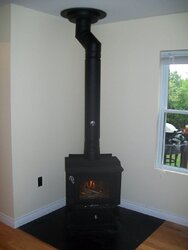
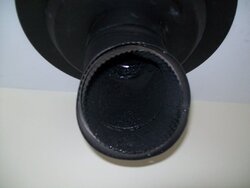
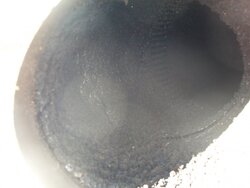
I had a new 6" prefab chimney installed last summer and put in an FW2470 stove made by Century Heating (owned by SBI, same co. as Drolet). The stove has been used daily since November and I make sure that I run it hot and not allow smouldering fires. Cord wood has ranged from dry to somewhat dry (usually mixed together) but never green or waterlogged. I've also used BioBricks made by a hardwood processing plant in Woodstock, NB. The probe temps range from 400 - 600 degrees when burning.
A few concerns have come up in the past week and I hope someone can offer some advice:
1). I noticed my doublewall stove pipe seemed hotter to the touch than usual even when the probe thermometer read 400 degrees. So I pulled down the pipe and saw a lot of soot buildup for the 4 months it was in use. Can this layer of soot soak up the heat and cause the doublewall to feel hotter than clean pipe? The soot was light and fluffy from the stove connector to the first 45 elbow, and turns into a harder substance in the 2nd elbow and is a mix beyond that. I bought a brush and rods this weekend so I'll sweep it.
2). Are SBI stoves known for soot buildup? I try to burn only short, hot fires and this stove's air cannot be cut back enough for an overnight burn so its not a slow smokey burn contributing to the soot problem.
I've attached a few pics of my setup. Thanks for any info you can pass along.





